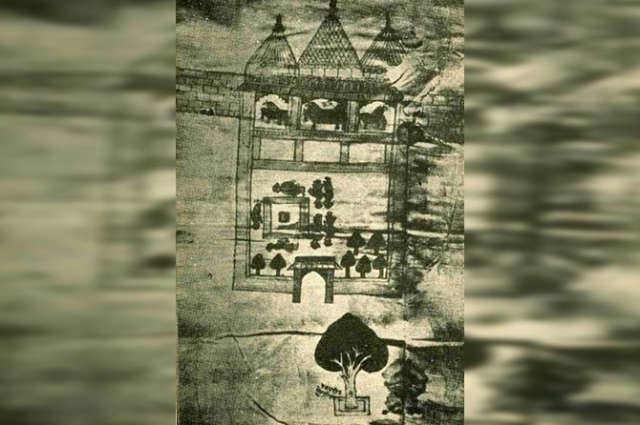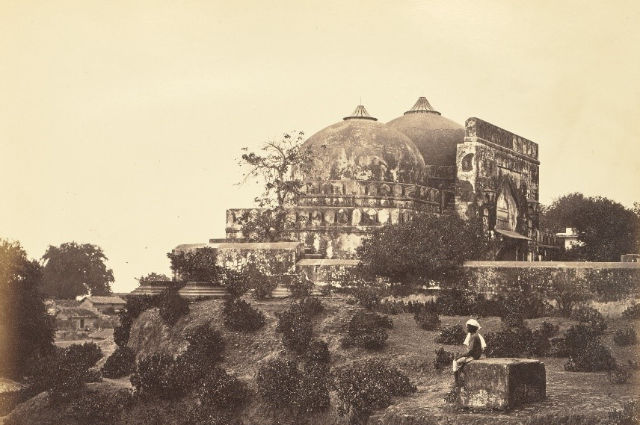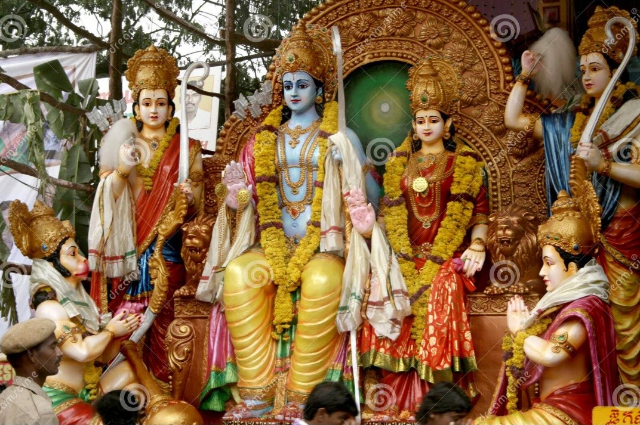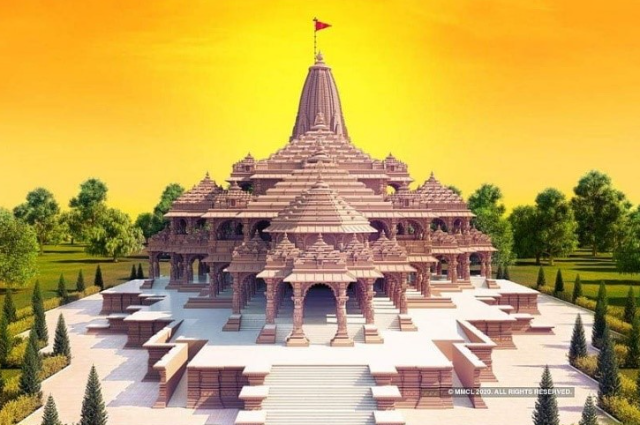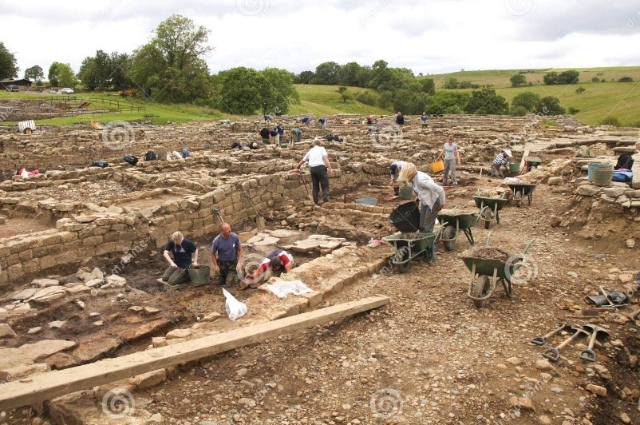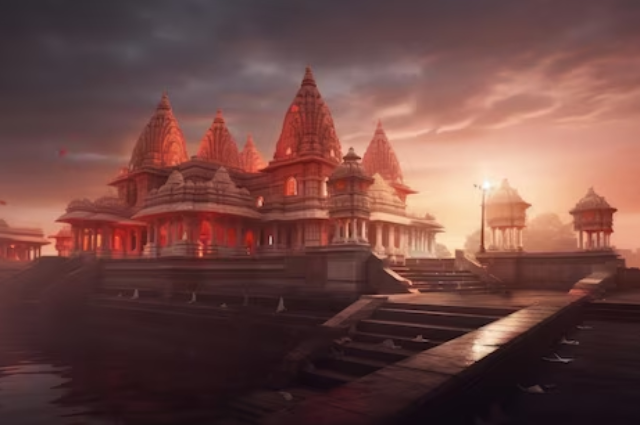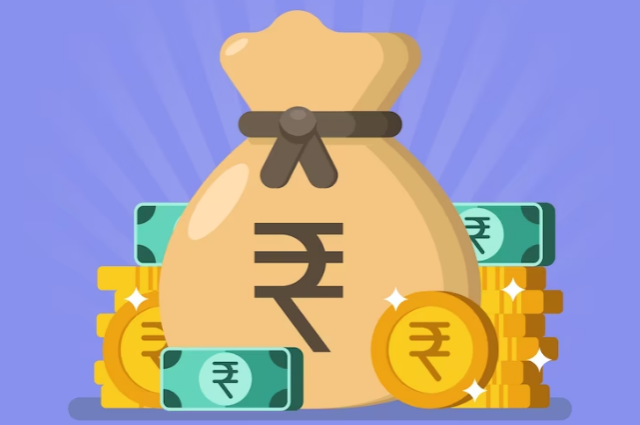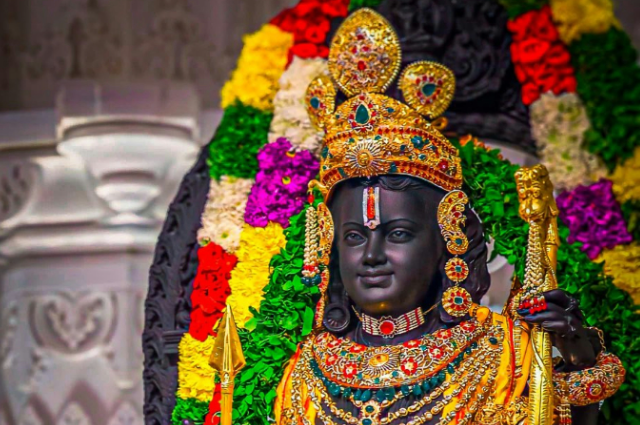
Photo by Saurabh Solanki on Unsplash
Introduction
The 'Pran Pratishtha' ceremony which marks the sanctification of the idol of Ram Lalla and the youthful avatar of Lord Ram is expected to involve participation from various societal sectors. This includes representatives from prominent spiritual and religious groups across the nation as well as delegates from different tribal factions and notable figures.
The ceremony according to the temple's trust is projected to conclude by 1 Pm. Following the ritual, the Prime Minister is scheduled to address the assembled audience. The 'Pran Pratishtha' ceremony despite its straightforward concept of instilling an idol with life involves a series of rituals deep-rooted in the Vedas and Puranas each holding its unique significance. One significant initial stage in this ceremony is the “Shobha Yatra”, a demonstration during which the idol is paraded around the temple's vicinity.
As the idol proceeds, observers' dedication is thought to transfer to it which results in instilling it with divine power and devotion. This signals the beginning of the idol's transformation into a deity. Once the idol is back in the mandap, the Pran Pratishtha rituals begin. Before Pran Pratishtha, the idol experiences several Adhivaas, involving immersion in various materials.
Prominent people from diverse traditions and cultures participate: The largest religious event
On January 22, the Pran Pratistha ceremony took place at the Shri Ram Temple premises which attracted a great assembly. This event will witness the presence of Acharyas from various schools of Indian spirituality, representatives from over 150 traditions, including Mahamandaleshwar, Mandaleshwar, Srimahant, Mahant, Naga, and more than 50 tribal communities such as Girivasis, Tatvasis, and islanders. Notably, this occasion marks a historic moment as residents from mountains, forests, coastal areas, and islands are participating collectively for the first time in India.
The program will host prominent figures from different traditions like Hnu Nami, Ramsanehi, Ghisapanth, Garibdasi, Gaudiya, Kabirpanthi, Valmiki, Shankardev (Assam), Madhav Dev, ISKCON, Ramakrishna Mission, Chinmaya Mission, Bharat Sevashram Sangha, Gayatri Parivar, Anukul Chandra Thakur Tradition, Mahima Samaj of Odisha, Akali, Nirankari, Namdhari (Punjab), Radhaswami and Swaminarayan, Varkari, Veer Shaiva, and more.
Following the completion of the Pran Pratistha program in the sanctum, dignitaries will have the opportunity to witness the blessing ceremony. The excitement surrounding the installation of Shri Ramlala is deep, and there is a collective resolve to celebrate this event with great enthusiasm throughout India including Ayodhya. People from different states are contributing gifts such as water, soil, gold, silver, gems, clothes, jewellery, bells, drums, and fragrances. Notable among these are the gifts, reminiscent of bhaaras, sent by Maa Janaki's maternal house from Janakpur (Nepal) and Sitamarhi (Bihar). Additionally, various types of Jewellery and gifts have been sent from Prabhu's maternal home in Raipur, Dandakaranya area.
Dispute in Ayodhya: from where and how it began?
In 1857, the dispute over the Babri Masjid site in Ayodhya began when the chief priest of Hanumangarhi associated with Vaishnav Bairagis, took control of the eastern part of the masjid courtyard and erected the Ram Chabutra, a platform marking the birthplace of Ram. Maulvi Muhammad Asghar, the muezzin of the mosque, filed a complaint about the forceful takeover. In response, the British government erected a wall in 1859 to separate the worship areas for Hindus and Muslims. Subsequently, Hindus entered from the east gate while Muslims used the north gate.
Despite Muslim petitions in 1860, 1877, 1883, and 1884 alleging wrongful actions, all were rejected. In 1885, Mahant Raghubar Das filed a lawsuit seeking legal title to the land and permission to construct a temple on the Chabutra. This case was distinctive because Mahant Raghubar Das asserted to be the mahant of the janmasthan (birthplace) Ayodhya, claimed the janmasthan to be the Chabutra, and notably, did not assert that any temple had previously stood where the mosque was erected. Despite appeals, the suit was dismissed in 1886.
Between 1870 and 1923, various official publications, including journals documented the destruction of at least three temples in Ayodhya, with mosques, including the Babri Masjid, erected on those sites. This official perspective was affirmed by the placement of a stone marker labelled "No Rama Janma-bhoomi" at the main entrance of the mosque. In December 1949, the Akhil Bharatiya Ramayana Mahasabha organized a nine-day recitation of the Ramcharitmanas by Tulsidas that resulted in the placement of idols of Rama and Sita inside the Babri Masjid on the night of 22-23 December.
By December 29, 1949, the Babri Masjid was declared a disputed property, leading to an order prohibiting Muslims from entering the mosque. Locks were placed on the main gate, while Hindus were granted permission for a devotional glimpse (darshan) of the idols through a side gate. Four priests were employed who were enjoying unrestricted access to the idols.
On January 16, 1950, Gopal Singh Visharad, a member of the Hindu Mahasabha, initiated a civil suit seeking unobstructed worship and a permanent injunction against the removal of idols. In 1959, the Nirmohi Akhara filed a suit asserting that the entire Babri Masjid should be handed over to them, contending it was not a mosque but a temple. On December 18, 1961, the Sunni Central Board of Waqfs filed a suit with a similar claim.
During a session in Delhi on April 7-8, 1984, the Vishwa Hindu Parishad (VHP) called for the removal of mosques in Ayodhya, Mathura, and Kashi, prioritizing Ayodhya. In 1986, the locks on the Babri Masjid were opened, and in 1987, the suits were moved from Faizabad to the Lucknow bench of the Allahabad High Court. Visharad's suit became known as Suit 1, while another suit (Suit 2) filed by Paramhans Ramchandra Dass was later withdrawn. The Nirmohi Akhara's suit was Suit 3, and the Sunni Central Board of Waqfs' suit was Suit 4.
In 1989, Suit 5 was filed in the name of Rama Lalla Virajman by Deoki Nandan Agrawal, a retired Allahabad High Court judge and vice-president of the VHP. The retired Hon’ble Judge Mr. Agrawal filed the suit as Rama Lalla’s sakha (“next friend”). After his demise, T P Verma became the sakha, and when he fell ill, Triloki Nath Pandey, a Rashtriya Swayamsevak Sangh (RSS) pracharak (activist), took over. Ravi Shankar Prasad of the Bharatiya Janata Party (BJP) served as the senior counsel for Suit 5.
The Babri Masjid Demolition
On December 6, 1992, a rally organized by the VHP and its affiliates including the BJP, brought together 150,000 supporters at the Babri Mosque site. Key BJP figures had delivered speeches during the event. As the speeches progressed the crowd became agitated, eventually storming at the gates of the mosque in the early afternoon. Despite a commitment to the Indian Supreme Court by the state government that the mosque would be protected, it was brought down within hours. The aftermath saw over 2000 casualties in riots across major Indian cities.
Following this, on December 16, 1992, the Indian government established the Liberhan Commission to investigate the circumstances surrounding the mosque's demolition. The commission, the longest-running in India's history, found various individuals responsible, including some prominent BJP leaders, then UP chief minister Kalyan Singh as well as VHP leaders. The report which was based on eyewitness testimonies, highlighted provocative speeches at the rally and suggested that the demolition could have been prevented if the leaders had chosen to intervene.
Despite the passage of time, Muslim organizations have continued to express outrage over the mosque's destruction. In 2005, terrorists attacked the makeshift temple at the site, and in 2007, threats were made against the head of the Ram temple. The demolition has also been cited as a pretext for terror attacks by banned jihadi groups like the Indian Mujahideen.
History of the findings Archaeological survey of Ayodhya
Following the appointment as the first Director General of the Archaeological Survey of India (ASI), Mr. Alexander Cunningham surveyed Ayodhya in 1862-63. His primary focus was identifying historical sites mentioned in Buddhist pilgrim records like those of Xuanzang and Faxien. Cunningham noted three mounts that were Mani Parbat, Kuber Parbat, and Sugriva Parbat, attributing them to existence in great ancient times. He identified two of them as stupas, the first built by Ashoka and the second supposedly containing the hair and nails of Buddha. The third was identified as a monastery.
During his survey, Cunningham also documented oral traditions and locations associated with the Ramayana, including the Janam Asthana, or the birthplace temple of Ram. Notably, he observed that Ayodhya lacked high mounts of ruins typically found in ancient cities. Instead, there were low irregular masses of land, depleted of bricks due to their use in constructing the neighbouring city of Faizabad. Cunningham acknowledged several Brahmanical temples but pointed out their modern construction, possibly on the sites of older temples destroyed by Muslims.
Cunningham's statement came to be relevant as despite mentioning the existence of a Janam Asthana temple, it had no connection to the Babri Masjid. He made no reference to the Babri Masjid standing on the site of a destroyed temple. In essence, Cunningham recorded various traditions linked to Ram but did not associate the Babri Masjid with a demolished temple in his findings.
In October 1990, an article was written for the RSS magazine Manthan, featuring a photograph from excavations in Ayodhya (1975-1980). The image displayed numerous brickbat heaps, claimed by archaeologists to be the pillar bases of a temple destroyed by Babar, serving as crucial archaeological evidence. It's noteworthy that this information, despite its archaeological significance, was published in a magazine affiliated with a political organization rather than an academic journal.
Paper presentation at the World Archaeological Inter-Congress
During a paper presented at the World Archaeological Inter-Congress in Croatia (May 1998), it was referred to a statement made on February 10, 1991, during a lecture in Vijayawada. In this statement, a suggestion came that the only way to establish a connection between the excavated pillar bases and the Babri masjid's stone pillars, as well as to determine if a temple existed beneath the masjid, was to excavate under the mosque. This proposition was reported by The Hindustan Times on February 11, 1991. When critiqued, the archaeologist responded with a reply in The Statesman on February 13, 1991, emphasizing the necessity for further excavations.
The implications of a former director general of the ASI advocating such excavations cannot be overlooked. The ASI ultimately carried out the task under court directions. The anticipated interpretations resulting from the ASI's excavations seemed almost predetermined.
Unfolding the chronological events of Ayodhya Ram Mandir and other events
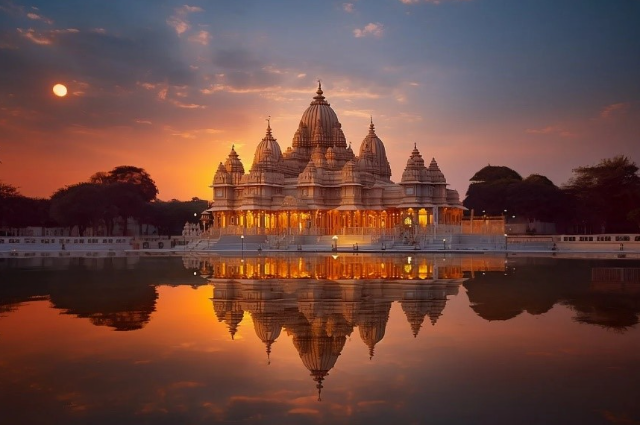
Image by Aditi Das from Pixabay
The Ayodhya dispute spanned 134 years and witnessed several critical events, resulting in enduring tensions between the Hindu and Muslim communities. Originating from the claim of Ayodhya being Lord Rama's birthplace and opposing mosque construction, it escalated with the demolition of the Babri mosque by Hindu kar Sevaks on December 6, 1992.
Highlighting key dates:
- 1524
Mughal emperor Babur's invasion established the Mughal dynasty.
- 1528
The uncertain construction date of Babri mosque was attributed to Mughal Commander Mir Baqi in 935 AH (1528-29).
- 1853
Communal violence erupted, Hindus contending the mosque was built after a temple demolition.
- 1859
Ongoing tensions led to a British-built fence, segregating the compound for Hindu and Muslim use.
- 1885
Mahant Raghu Bir Das's plea for a Ram Chabootra canopy was rejected by Faizabad district court which led to the marking of the judiciary's involvement.
- 1949
Hindu activists placed Lord Rama's idol inside the temple which led to triggering controversy and civil suits between communities.
- 1950
Hindus sought worship rights in the disputed area which led to a court decision withholding a verdict but allowing worship on the contested land.
- 1950
Initiating legal action, Hindu parties as being represented by Gopal Simla Viharad and Paramhansa Ramachandra Das, filed two suits in Faizabad Court. Their objective is to obtain permission for Hindu pujas to be conducted for Ram Lalla. The Court grants permission for the pujas and issues orders to keep the inner courtyard gates locked.
- 1959
A third Hindu suit was filed by Nirmohi Akhara that was aiming to claim possession of the disputed land.
- 1961
Adding to the legal proceedings, the UP Sunni Wakf Board files a Muslim suit, seeking possession of the Babri Mosque site. In addition to seeking ownership, another demand was the removal of Ram Idols from Babri Masjid.
- 1984
Commencement of the Ram Janmbhoomi Movement – Vishwa Hindu Parishad (VHP) establishes a group to initiate the Ram Janmbhoomi Movement with BJP leader LK Advani leading the campaign.
- February 1st, 1986
Opening of the Inner Gate of Babri Mosque – Lawyer UC Pandey, acting as a third party, appeals for the unlocking of the gates before the Faizabad Session Court. The basis of the appeal is that the closure order was issued by the Faizabad district administration, not a court.
Responding to this, the District Judge orders the removal of the locks, permitting Hindu "pooja and darshan." In reaction, Muslims form the Babri Mosque Action Committee (BMAC) to express their protest against this decision.
- 9th November, 1989
On November 9th, 1989, PM Rajiv Gandhi granted permission for the Vishwa Hindu Parishad (VHP) to conduct the Shilanayas ceremony involving the laying of the foundation stone near the disputed area. In 1989, all title suits related to the matter were transferred to the Allahabad High Court. Additionally, a suit named after Ram Lalla Virajman was filed in the High Court with parties from the Nirmohi Akhara (1959) and Sunni Waqf Board (1961) suits.
- September 25th, 1990
Subsequently, on September 25th, 1990, LK Advani initiated a Rath Yatra, starting from Somnath in Gujarat and heading towards Ayodhya in Uttar Pradesh. The purpose of the Yatra was to rally support for the movement. Unfortunately, this led to communal riots breaking out in the region.
- December 6th, 1992
On December 6th, 1992, the Babri Mosque was forcefully demolished by a violent mob of Karsevaks. In the aftermath of the destruction, the Karsevaks erected a makeshift temple at the site.
- December 16th, 1992
Subsequently, on December 16th, 1992, just 10 days after the mosque's demolition the Prime Minister established the Liberhan Commission. This committee headed by retired High Court Justice M. S. Liberhan was tasked with investigating the circumstances surrounding the Babri Mosque's demolition and the communal riots that followed. Originally, the Commission was mandated to submit its report within three months of its formation.
- January 7th, 1993
On January 7th, 1993, the Narsimha Rao Government took a significant step by issuing an ordinance to acquire 67.7 acres of land in Ayodhya including the site and its surrounding areas. This ordinance later evolved into a law known as the Acquisition of Certain Areas at Ayodhya Act, 1993, enabling the Central government to acquire the specified land.
- 1994
In the following year, 1994, a key legal development occurred with the Ismail Faruqui Judgment. The Supreme Court in a majority decision of 3:2, affirmed the constitutionality of the Acquisition of Certain Areas at Ayodhya. This judgment set the legal framework supporting the government's authority to acquire the designated areas in Ayodhya.
- April 2002
In April 2002, the Lucknow Bench of the Allahabad High Court commenced the hearings for the Ayodhya Title Dispute case marking it as the beginning of the legal proceedings.
- Between March and August 2003
The Archaeological Survey of India (ASI) conducted a survey as directed by the Allahabad High Court. The excavation aimed to explore the ground beneath the disputed site. According to the ASI, it uncovered remains of a Hindu Temple dating back to the 10th century. However, the authenticity of these findings was contested by Muslims who raised questions about the ASI report.
- June 30th, 2009
On June 30th, 2009, the Liberhan Commission after a 17-year delay, submitted its report to the Prime Minister. Notably, the contents of the report were not disclosed to the public at that time.
- September 30th, 2010
On September 30th, 2010, the Allahabad High Court issued a significant judgment in the Ayodhya dispute, delineating the land into three portions. The division allocated one-third of the land to the Sunni Wakf Board, another third to the Nirmohi Akhara and the remaining third to Ram Lalla Virajman.
The ruling from the Lucknow Bench of the High Court delivered in a 2:1 ratio, reflected the court's decision to distribute the disputed land between the Muslim and Hindu litigants. This allocation aimed to address the longstanding dispute and provide a legal resolution to the ownership claims.
The High Court assigned the structure that once belonged to the demolished Babri Masjid, where the present makeshift temple is situated to the Hindu community. This particular site was the result of the demolition carried out by a group of Karsevaks on December 6, 1992. Additionally, the nearby Ram Chabutra and Sita Rasoi were allocated to the Nirmohi Akhara. The outer courtyard of the disputed land constituting one-third share was designated for the Sunni Wakf Board.
- May 2011
In May 2011, the Supreme Court intervened by putting a stay order on the ruling of the Allahabad High Court. The Supreme Court acknowledged various petitions from all involved parties. Justices Aftam Alam and R.M. Lodha of the Division Bench criticized the High Court's decision by labelling it as "strange." Justice Lodha highlighted that the High Court had introduced a new aspect by issuing a partition decree, a remedy not sought or requested by any party involved. The court deemed this order peculiar, questioning the legitimacy of passing a partition decree when none of the parties had sought it.
- March 21, 2017
Moving forward to March 21, 2017, former Chief Justice Khehar proposed an alternative resolution by suggesting an out-of-court settlement among all parties involved.
- Between February and July 2018
The petitioners argued that the Supreme Court should refer the 1994 Ismail Faruqui judgment to a 7-judge Bench for reconsideration.
- July 20th, 2018
The Supreme Court reserved its verdict, taking time to decide whether to refer the appeal to a larger Bench.
- September 2nd, 2018
The Supreme Court declined to form a larger Bench. In a split decision with a majority of 2:1, the three-judge bench concluded that the 1994 Ismail Faruqui judgment did not require reconsideration by a larger bench. However, on January 8th, 2019, Chief Justice Gogoi utilized his administrative powers to assemble a 5-judge Constitution Bench, overturning the September 2018 judgment and reopening the matter for consideration.
- March 8th, 2019
Following a two-day series of hearings, the Constitution Bench of the Supreme Court directed court-monitored mediation, a decision made despite resistance from certain significant parties involved. The mediation process was scheduled to conclude in mid-May 2019.
The mediation process commenced on March 13th and was initially scheduled to conclude in early May. However, on May 10th, the court extended the mediation period until August 15th in response to requests from multiple parties.
On July 9th, Gopal Singh Visharad, one of the involved parties requested the court to resume day-to-day court hearings, citing a perceived lack of progress in the ongoing mediation efforts.
Subsequently, on August 6th, the court initiated final arguments, starting with the presentation from the Nirmohi Akhara, followed by Shri Ram Virajman and various other Hindu parties. The current phase involves hearing arguments from the Sunni Waqf Board. Former Chief Justice Gogoi had urged all parties to conclude their arguments by October 18th.
On October 16th, the court withheld its decision, and it is anticipated that the verdict will be announced prior to the retirement of the former Chief Justice Ranjan Gogoi on November 17th.
On November 9th, 2019, the court issued its verdict granting the title to the deity Shri Ram Virajman. Additionally, the court directed the State to provide an alternative site in Ayodhya to the Sunni Waqf Board for the construction of a mosque.
Mumbai Riots during Ayodhya Dispute
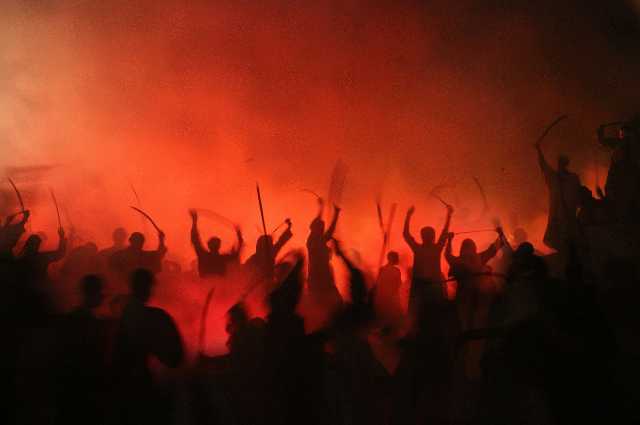
Photo by Hasan Almasi on Unsplash
The Ayodhya dispute, marked as a sensitive issue by the Supreme Court, resulted in numerous riots and a conflict between Hindu and Muslim communities. This prolonged case not only led to communal tensions but also created emotional turmoil nationwide, diminishing the essence of secularism. The originally land-focused dispute transformed into a broader communal conflict that persisted even after the court's decision. Tragically, lives were lost in the riots with Mumbai being significantly impacted.
In 1992, the demolition of the mosque by Vishwa Hindu Parishad (VHP) members triggered disturbances in Mumbai. The repercussions escalated on March 12, 1993, when a bomb blast claimed around 700 lives, leading to the migration of minority communities. The aftermath of the Ayodhya dispute continues to influence Mumbai where a preference for Hindutva is evident and some individuals are actively isolating themselves from other communities. Despite the court's judgment emphasizing secularism, haunting disparities persist particularly between Hindu and Muslim communities in the city.
How Ram Temple is a true representation of India and a national marvel?
Arun Yogiraj, hailing from Karnataka's Mysuru, skilfully crafted the idol of Ram Lalla. The stone utilized in sculpting the idol is also sourced from Mysuru. Chandrakant B Sompura, the temple architect from Ahmedabad, played a crucial role in the project. The temple's marble originates from the renowned Makrana in Rajasthan, and the polished teakwood used in construction was procured from Maharashtra.
Previously, the construction of the temple incorporated sacred soil from over 2,500 locations across India, including Jhansi, Bithoor, Haldighati, Yamunotri, and the Golden Temple. Additionally, soil from Ayutthaya City in Thailand, linked to Ayodhya was also used. Water from 155 countries, such as Pakistan, Uzbekistan, China, Germany, and Bangladesh, was gathered for the sacred bath ceremony, attended by more than 6,500 individuals from various backgrounds.
The event welcomed many great religious persons from 150 schools of thought, and worship systems, and individuals from diverse fields like science, sports, arts, music, dance, and writing, as well as representatives from industry, government, and defence services. The ceremony showcased musical instruments from every Indian state.
The deity's offering included special prasadas from Mahakaal, Ujjain, Mehndipur Balaji, Dausa, Banke Bihari temple, Mathura, and those prepared by the temple itself. The construction of the temple involved continuous 24X7 efforts in the final stages with skilled workers from Rajasthan, Odisha, and Bengal hired for the complicated and unique artwork.
The collective effort reflected the essence of being an Indian with contributions from common people exceeding 85% often in denominations of less than Rs 50. Ayodhya Mayor Mahant Girishpati Tripathi emphasized that Ram symbolizes India resonating with the belief in "Sabke Ram" and "sab mein Ram" (Ram for all & Ram in all).
Former vice-chancellor of Ram Manohar Lohia Avadh University, Manoj Dixit, highlighted Ayodhya's unique diversity being the only city with temples representing 64 castes and communities of India each worshipping Ram in their distinctive ways.
Evidence found through the Archaeological Survey in Ayodhya
Archaeologist K.K. Muhammed, the former Region Director (North) of the Archaeological Survey of India (ASI), was the first to suggest that Muslims should surrender the Babar Masjid area to Hindus. This recommendation stemmed from his discovery that the mosque was constructed over the fragments of a temple. During the exploration around Babri Masjid, Muhammed's team identified 12 temple pillars supporting the structure ornamented with Purna Kalasha, a significant Hindu symbol denoting prosperity. The walls of the mosque displayed disfigured engravings of Hindu deities, and a brick base supported the pillars. Surprisingly, terracotta idols prohibited in Islam were also uncovered in the vicinity, leading Muhammed to assert that these findings indicated the presence of a temple beneath the mosque.
GPR Report findings and was there any confusion around it?
Archaeological investigations in Ayodhya in 2003 were initiated following a high court order on August 1, 2002, directing the Archaeological Survey of India (ASI) to conduct excavations at the site. Before objections from concerned parties were addressed, a ground-penetrating survey (GPR) of the former Babri Masjid site was planned. Tojo-Vikas International, commissioned by the ASI, conducted the GPR survey from December 30, 2002, to January 17, 2003, submitting a report to the ASI director general. The report identified differences of varying depths, suggesting ancient structures like pillars, foundation walls, and slab flooring.
However, concerns arose regarding the GPR report's conclusions. The report, mentioning pillars, contradicted the subsequent excavations that found only two pillars in the debris of the Babri Masjid that were piled up after its demolition in 1992. The makeshift shrine with the deity Rama Lalla emerged above this debris during a period of mayhem. The surface material cannot be considered valid archaeological evidence as it may have been brought from elsewhere.
Furthermore, discrepancies were noted in the geophysical interpretation map, and attempts to confirm variances recorded by the GPR survey revealed that only a portion was verified while some were not found, and others couldn't be verified due to the significance of higher-level structures. The limitations in verifying doubts raised questions about the accuracy and reliability of the GPR survey findings.
Following the identification of walls, pillars, and slab flooring beneath the ground during the survey, the high court issued an order on March 5, 2003, instructing the Archaeological Survey of India (ASI) to conduct excavations. The purpose was to confirm the nature of irregularities indicated by the ground-penetrating survey (GPR) and to determine whether the existing structure had been built on the site of a Hindu temple after demolishing it.
The ASI commenced a comprehensive survey and trench layout on March 12, 2003, employing the Wheeler method of excavating in a grid pattern with a 1-meter unexcavated soil layer between trenches. Manual labourers were engaged for digging, with each trench supervised by a designated trench supervisor responsible for maintaining daily records. It's noted that one trench might have had multiple supervisors, and the site notebooks, recording starting and closing depths, layer numbers, features, and artifacts, often contained information on several trenches.
The documentation included daily registers providing information on trenches dug, starting and closing depths, and the artifacts, bones, and waste discovered. At the end of each working day, recovered antiquities, bones, and waste material were presented to the concerned parties for signatures in the daily register. An ancient times register was maintained, detailing artifacts with trench and layer numbers, depths, dimensions, and descriptions, assigning them registration numbers. A total of 90 trenches were excavated, covering practically the entire area.
The frequent argument arises that Muslim parties assert the Babri Masjid was constructed on barren land without any underlying structure. It is emphasized that introducing new claims or evidence suggesting an Islamic structure underneath is not permissible. In contrast, the contention is that since Hindus consistently maintained the existence of a temple beneath the Babri Masjid, any structure unearthed in excavation must be a temple. However, it's crucial to recognize that there might be a lack of historical or oral evidence for a preceding Islamic structure, yet archaeological findings may indicate otherwise. The prevalent perception both among the general public and certain archaeologists and historians in India is that archaeology's role is merely to validate written texts or oral traditions. Consequently, even when evidence contradicts this alternative explanations face limited acceptance.
How will Ram Mandir be bringing positive changes even in businesses?
It marks a momentous occasion as the Ayodhya Ram Mandir welcomes devotees, signifying a day of great significance both religiously and entrepreneurially. From a religious standpoint, this day holds immense importance as it signifies the conclusion of years of debate over establishing Shri Ram's residence in his birthplace. On the entrepreneurial front, this event unfolds new prospects for aspiring business minds.
The establishment of the Ram Mandir stands as a crucial factor and it’s confident to say that it will bring positive transformations. Its construction is anticipated to result in enhanced infrastructure, including improved roads, transportation facilities, and overall urban development in Ayodhya. This not only elevates the quality of life for the locals but also creates avenues for entrepreneurs, particularly in the construction and real estate sectors.
An uprising curve outcome will be seen in the tourism sector. As a major pilgrimage site, the Ram Mandir is expected to draw an extensive entry of devotees and tourists. This surge in visitors will generate a heightened demand for hospitality services, translating to increased profits for local entrepreneurs in the hotel and restaurant industry. Moreover, the retail sector is poised for growth as tourists indulge in shopping for goods and local products, further contributing to the economic prosperity of the region.
The upswing in employment opportunities is going to unfold across various sectors. The heightened demand for both skilled and unskilled labour in construction, tourism, and related industries is set to create a substantial surge in job openings. These employment options hold the promise of promotion of a more prosperous local community and that will benefit the residents.
Entrepreneurs engaged in the transport sector are also self-confident for positive transformations. The ever-increasing tourism industry will drive a bigger need for transportation services, including taxis, buses, and various modes of travel. This presents a favourable moment for local entrepreneurs to invest in and expand their transport businesses, capitalizing on the expanding demand.
In addition to the direct economic impacts, the inauguration of the Ram Mandir is anticipated to increase networking opportunities. Entrepreneurs in Ayodhya will find themselves in a positive position to engage in collaborations and form partnerships with businesses across various sectors. This collaborative environment is expected to not only foster economic growth but also contribute to the diversification of the local economy.
Conclusion
The inauguration of the Ram Mandir marks a significant milestone for Ayodhya, positioning it as a prominent global religious destination. Projections indicate that religious tourism will play a substantial role contributing more than 10% to India's GDP in the predictable future. Ayodhya's evolution into a key tourist hub is expected to produce growth across various sectors to cater to the increasing demands. This transformation presents an extensive and continuing opportunity for startups and Micro, Small, and Medium Enterprises (MSMEs) to introduce innovative solutions spanning multiple domains. Additionally, there is a notable trend among spiritual tech startups capitalizing on this momentum by introducing virtual experiences and online offerings to enhance the spiritual journey for enthusiasts.
The consecration is widely perceived as a central hub aimed at fostering peace and tolerance, stressing universal values that go beyond religious and cultural boundaries. The temple is envisioned to cultivate a feeling of devotedness and unity among various communities by offering a communal cultural and religious focal point. Additionally, it is regarded as a shared civic duty underlining the significance of our collective values and beliefs. The temple serves as a reminder of the moral values and ethical principles linked to Lord Ram, emphasizing qualities like righteousness, justice, and the pursuit of dharma (duty).
. . .
Disclaimer: This article is based on various facts and references taken from research blogs, Media resources, and studies. It doesn't attempt to hurt any sentiments and doesn’t discriminate among any ethnic community, caste, religion, gender, sex, or place of birth. The author and Reflections.live team are not liable for any sort of legal action against them. This article contains details based on true events and some readers may find it distressing. By reading this blog, readers give consent that the views in this article are opinions based and readers might agree or disagree with the same for which they can’t sue the author or Reflections.live team or people associated with this blog directly or indirectly, for any sort of disagreements in case they have. Further Reflections.live team and the author have high regard and respect for all opinions.
References:
- http://lib.bjplibrary.org/jspui/handle
- https://www.financialexpress.com/india
- https://timesofindia.indiatimes.com/city
- https://www.scobserver.in/cases
- https://www-news18-com.cdn.ampproject.org
- https://www.google.com
- https://www.scobserver.in/cases
- https://timesofindia.indiatimes.com
- https://www.deccanherald.com/india

